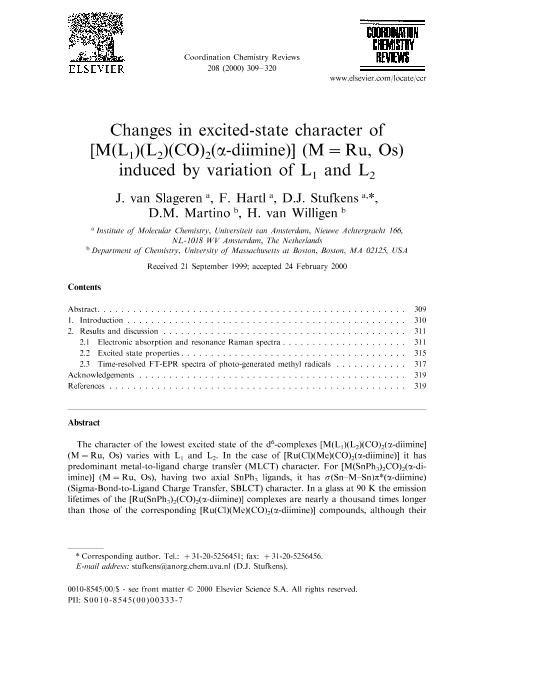Mostrar el registro sencillo del ítem
dc.contributor.author
van Slageren, J.
dc.contributor.author
Hartl, F.
dc.contributor.author
Stufkens, D.J.
dc.contributor.author
Martino, Debora Marcela

dc.contributor.author
van Willigen, H.
dc.date.available
2017-11-07T18:53:50Z
dc.date.issued
2000-12
dc.identifier.citation
van Slageren, J.; Hartl, F.; Stufkens, D.J.; Martino, Debora Marcela; van Willigen, H.; Changes in excited-state character of M(L1)(L2)(CO)2(α-diimine) (M=Ru, Os) induced by variation of L1 and L2; Elsevier Science Sa; Coordination Chemistry Reviews; 208; 12-2000; 309-320
dc.identifier.issn
0010-8545
dc.identifier.uri
http://hdl.handle.net/11336/27763
dc.description.abstract
The character of the lowest excited state of the d6-complexes [M(L1)(L2)(CO)2(α-diimine] (M=Ru, Os) varies with L1 and L2. In the case of [Ru(Cl)(Me)(CO)2(α-diimine)] it has predominant metal-to-ligand charge transfer (MLCT) character. For [M(SnPh3)2CO)2(α-diimine)] (M=Ru, Os), having two axial SnPh3 ligands, it has σ(SnMSn)π*(α-diimine) (Sigma-Bond-to-Ligand Charge Transfer, SBLCT) character. In a glass at 90 K the emission lifetimes of the [Ru(SnPh3)2(CO)2(α-diimine)] complexes are nearly a thousand times longer than those of the corresponding [Ru(Cl)(Me)(CO)2(α-diimine)] compounds, although their emission energies are very similar. In fact, these lifetimes are extremely long (e.g. τ=1070 μs for [Ru(SnPh3)2(CO)2(4,4′-dimethyl-2,2′-bipyridine)]) for a CT state. Although replacement of Ru by Os decreases both the emission energy and lifetime of complexes such as [M(bpy)3]2+ (M=Ru, Os), only the emission lifetime decreases in the case of the [M(SnPh3)2CO)2(α-diimine)] compounds. The latter effect is due to the increase of spin-orbit coupling (SOC), the influence of which could thus be studied without taking into account any energy-gap-law effect. Preliminary photophysical data are presented for [Pt(SnPh3)2(Me)2(i-Pr-DAB)], which has very similar excited state properties as the corresponding Ru- and Os-complexes. Replacement of a SnPh3 ligand by a methyl group to give [Ru(Me)(SnPh3)(CO)2(i-Pr-DAB)] increases the photoreactivity of the complex. The weaker RuMe bond is broken homolytically and the formation of methyl radicals was studied in detail with FT-EPR spectroscopy.
dc.format
application/pdf
dc.language.iso
eng
dc.publisher
Elsevier Science Sa

dc.rights
info:eu-repo/semantics/openAccess
dc.rights.uri
https://creativecommons.org/licenses/by-nc-sa/2.5/ar/
dc.subject.classification
Otras Ciencias Químicas

dc.subject.classification
Ciencias Químicas

dc.subject.classification
CIENCIAS NATURALES Y EXACTAS

dc.title
Changes in excited-state character of M(L1)(L2)(CO)2(α-diimine) (M=Ru, Os) induced by variation of L1 and L2
dc.type
info:eu-repo/semantics/article
dc.type
info:ar-repo/semantics/artículo
dc.type
info:eu-repo/semantics/publishedVersion
dc.date.updated
2017-11-03T20:26:48Z
dc.journal.volume
208
dc.journal.pagination
309-320
dc.journal.pais
Países Bajos

dc.description.fil
Fil: van Slageren, J.. Universiteit van Amsterdam; Países Bajos
dc.description.fil
Fil: Hartl, F.. Universiteit van Amsterdam; Países Bajos
dc.description.fil
Fil: Stufkens, D.J.. Universiteit van Amsterdam; Países Bajos
dc.description.fil
Fil: Martino, Debora Marcela. Consejo Nacional de Investigaciones Científicas y Técnicas. Centro Científico Tecnológico Conicet - Santa Fe. Instituto de Desarrollo Tecnológico para la Industria Química. Universidad Nacional del Litoral. Instituto de Desarrollo Tecnológico para la Industria Química; Argentina
dc.description.fil
Fil: van Willigen, H.. University of Massachusetts at Boston; Estados Unidos
dc.journal.title
Coordination Chemistry Reviews

dc.relation.alternativeid
info:eu-repo/semantics/altIdentifier/doi/http://dx.doi.org/10.1016/S0010-8545(00)00333-7
Archivos asociados
